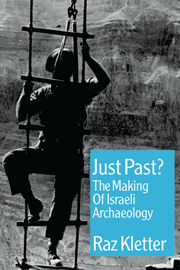Book contents
- Frontmatter
- Dedication
- Contents
- List of illustrations
- Introduction
- Acknowledgements
- Abbreviations
- 1 Archaeology and the 1948 War
- 2 Abandoned places, new places
- 3 Foreign aid
- 4 Frozen funds
- 5 A battalion of guards
- 6 Relief work
- 7 Man robs his land: “agreement” with General Dayan
- 8 “Gold of Ophir for Beth-Horon”: 3,000 shekels
- 9 The building beyond the border: the PAM, 1948–67
- 10 A building of dreams: a home for the IDAM and the origins of the Israel Museum, Jerusalem
- 11 A dead man on the council: the story of the supreme archaeological body in Israel
- 12 “But trust comes from the heart”: travels with the Government Tourist Corporation
- 13 “Whether in a courtyard of a synagogue, in a courtyard adjacent to a synagogue, or under a synagogue”: the Safad affair
- 14 The policy of salvage and early Israeli excavations
- 15 Myths and conclusions
- Appendix: other documents from the IDAM files
- Bibliography
- Author index
- Index
14 - The policy of salvage and early Israeli excavations
- Frontmatter
- Dedication
- Contents
- List of illustrations
- Introduction
- Acknowledgements
- Abbreviations
- 1 Archaeology and the 1948 War
- 2 Abandoned places, new places
- 3 Foreign aid
- 4 Frozen funds
- 5 A battalion of guards
- 6 Relief work
- 7 Man robs his land: “agreement” with General Dayan
- 8 “Gold of Ophir for Beth-Horon”: 3,000 shekels
- 9 The building beyond the border: the PAM, 1948–67
- 10 A building of dreams: a home for the IDAM and the origins of the Israel Museum, Jerusalem
- 11 A dead man on the council: the story of the supreme archaeological body in Israel
- 12 “But trust comes from the heart”: travels with the Government Tourist Corporation
- 13 “Whether in a courtyard of a synagogue, in a courtyard adjacent to a synagogue, or under a synagogue”: the Safad affair
- 14 The policy of salvage and early Israeli excavations
- 15 Myths and conclusions
- Appendix: other documents from the IDAM files
- Bibliography
- Author index
- Index
Summary
Iron are our lives
Molten right through our youth.
A burnt space through ripe fields
A fair mouth's broken tooth.
Isaac Rosenberg, “August 1914” (1949: 70)THE DARK SIDE
The British Mandatory period is “generally regarded as the formative ‘Golden Age’ of Archaeology in Palestine” (Gibson 1999: 115, with references). True, the period signalled unprecedented progress, but it was not very difficult to improve Ottoman Palestine. There remained many dark spots: ethnic groups were segregated; the bulk of archaeological research was carried out by foreigners; the Law of Antiquities was accomplished at the price of creating legal trade in antiquities (Kletter & Kersel, forthcoming) and each separate group was interested in “our past” (Jews in synagogues; Arabs in Islamic periods and so on) (Broshi 1986: 25–6; Gibson 1999; Ben-Arieh 1999a,b, 2001; Abu el-Haj 2002).
Early Israeli archaeology was very popular (Fig. 29).By 1958 the IES had 1,500 local members and 200 members abroad (BIES 16 (1951/52): 76). Hundreds were attending annual conferences: 300 in 1948, 500 in 1949, 800 in 1957 (BIES 15 (1949/50): 124, 19 (1960–61): 87; Alon 3 (1951): 57). The young were also interested (Yeivin 1960: 2; cf. Dever 1985: 43; Elon 1997: 41–3; Rosen, in press). IES members came, as a whole, from the upper classes. State leaders were enthusiastic about archaeology: President Ben-Zvi was a keen scholar and David Ben-Gurion chaired a Bible study circle.
- Type
- Chapter
- Information
- Just Past?The Making of Israeli Archaeology, pp. 295 - 309Publisher: Acumen PublishingPrint publication year: 2006



